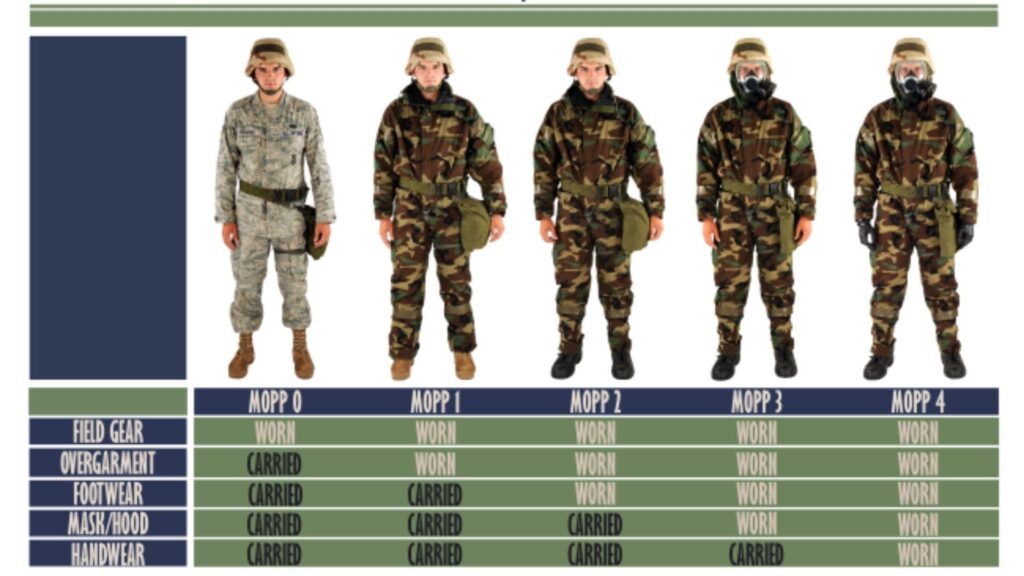Unlike NBC suits, which are open and close for airflow, MOPP gear retains body heat, limits heat loss, and inhibits sweating. This reduces the ability to regulate temperature and increases the risk of dehydration, performance degradation, and heat illness. Consequently, soldiers wear the most protective MOPP level (MOPP 4) only when the threat of vapor absorption and contact is high. The full suite includes over garment, over boots, and a protective mask with hood.
What is MOPP Gear?
MOPP gear is the equipment used to protect soldiers, sailors, and airmen from nuclear, biological, and chemical threats (NBC). It consists of an overgarment, overboots, gloves, and mask. The military has five different levels of MOPP, which vary in terms of how quickly they can be donned and the level of protection they provide.
MOPP zero provides the least protection of all the levels, but it is still a significant improvement over regular combat uniforms. Its most important feature is its ability to detect liquid chemical agents, such as nerve agents, by using M9 paper. The paper will turn reddish brown if it comes into contact with a liquid agent. Troops will wear this overgarment with their battle dress uniform (BDU), and it can be upgraded to higher levels as conditions change.
While the MOPP gear encapsulates soldiers from most chemical and biological threats, it has limitations. For example, the hood and gloves restrict movement and must be removed to eat or drink. Soldiers are also unable to work very long or at high rates when wearing MOPP, and they may experience heat stress. They also risk losing their balance or falling while wearing the mask. To prevent this, soldiers practice with their equipment in realistic training scenarios.

What are the Five Levels of MOPP?
As the threat level assessed by higher headquarters increases, units move to increased levels of MOPP. Leaders must be familiar with standard MOPP levels so they can apply a consistent and educated approach to their unit’s NBC defense postures. The MOPP system has five levels, each indicating different protective gear and readiness levels. These levels help military personnel to respond appropriately to potential CBRN hazards. The five levels of MOPP are:
- MOPP Level 0: At this level, personnel are not wearing any protective gear and are essentially in a regular uniform. This level is used when the threat of a CBRN attack is low and no immediate protective measures are required.
- MOPP Level 1: Personnel at this level wear the protective mask (gas mask) as a precaution while the rest of their gear remains unchanged. This level is typically used when there is a potential for a CBRN threat, but the risk is not yet imminent.
- MOPP Level 2: In addition to wearing the protective mask, personnel at this level don the overgarment, which is a protective suit designed to shield against contamination. Gloves and boots are also worn. This level indicates an increased risk of CBRN exposure, and personnel are required to be prepared to put on the rest of their gear quickly.
- MOPP Level 3: At this level, personnel put on the protective mask, overgarments, gloves, and boots. Additionally, they wear the protective mask carrier and carry the individual decontamination kit. MOPP Level 3 indicates a higher threat level, and personnel are prepared for potential contamination.
- MOPP Level 4: This is the highest level of readiness. Personnel wear all of the protective gear, including the mask, overgarment, gloves, and boots. They also carry the individual decontamination kit, chemical protective gloves, and coveralls. MOPP Level 4 is used when there is a confirmed CBRN threat, and the risk of contamination is significant.
Increasing the level of MOPP gear protects soldiers from the threat of exposure to chemicals or bacteriological agents that can attack through skin or mucous membranes, but it also increases heat casualties as well as performance degradation from the physical stresses of encapsulation. This makes it critical that commanders weigh the threat-related risks and the impact of MOPP against other mission-related concerns, such as a requirement for timely action.
As the threat level increases, units move to increased levels of MOPP 4. The full protective posture consists of overgarments, overboots, gloves, gas masks, and hoods. In this configuration, the protective ensemble provides a barrier against nuclear, chemical, or bacteriological agents in liquid or aerosol forms as well as radiological contamination from beta and alpha particles. Despite this gear’s impressive level of protection, the overall effect is psychologically stressful. This is why tough, realistic METL-driven training with the use of MOPP is important.
